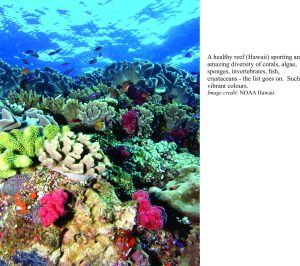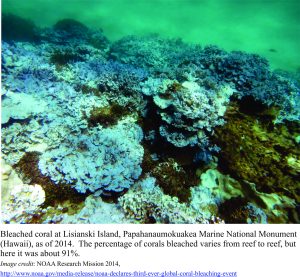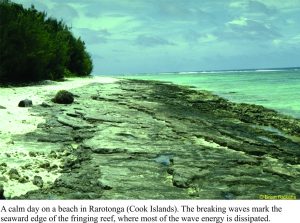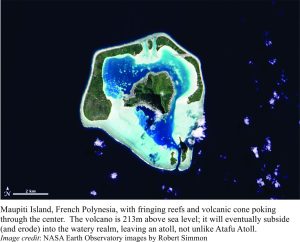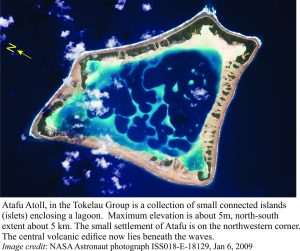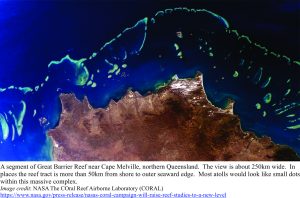Anyone who has swum, snorkeled, or dived among coral reefs, will breach the sea surface a different person. The unimaginable diversity of life, the vitality, colour, texture, are breathtaking. Apex predators keep silent watch; minuscule crustaceans scurry from polyp to shelly crag. Life and death and life, chapter and verse.
Alas. So many reef tracts (atolls, fringing reefs, barriers) have suffered massive bleaching and die-back; instead of the vibrant reds and yellows, they now sport dirty grey colours with splotches of algal green. Reports of dying reefs are everyday news; Australia’s Great Barrier Reef garnering headlines for all the wrong reasons. Bleaching does not kill the reef-building organisms, but it does put them under severe stress, such that if living conditions don’t return quickly to normal, the organisms (polyps) will die. Some bleached reefs are recovering, but others are not. Increased sediment runoff (from rivers) and pollutants will compromise reef health (these tend to be localised problems), but the primary cause for the latest events seems to be elevated (shallow) ocean temperatures through huge swaths of the Pacific and Atlantic oceans, the Caribbean and South China seas (NOAA’s Coral Reef Watch provides updates of abnormal temperature conditions and degree of reef stress).
Reefs and waves go hand in hand, a kind of biological-physical symbiosis. Waves oxygenate water (all that agitation), continually bathe the entire reef to maintain uniform temperatures, distribute food and spawn, and act as a cleaning agent by distributing broken coral and sediment across the adjacent sea floor. Reefs, in turn, buffer waves as they approach the coast and in so doing, protect lagoons and beaches (an area referred to as the Back-reef) from excessive erosion. Cyclones and hurricanes will occasionally breach these defenses, damaging reefs and pushing waves across the shore. But healthy reefs will recover, re-establishing a kind of dynamic equilibrium within the entire system.
So what happens when large reef complexes are degraded?
As ocean waves move into shallow water they begin to interact with the sea floor, dissipating some of their energy in the process (i.e. the energy associated with friction). Coral reefs absorb much of the wave energy because their seaward margins are highly irregular and rough; everywhere you look there are nooks and crannies among the myriad forms of coral, sponges and algae (the scientific article here is Open Access). Waves that interact with the rough reef exterior generate eddies and turbulence; the energy to do this must come from the waves themselves such that the total energy in a wave decreases. Corals are sometimes damaged by large, energetic waves during storms, but they will usually regrow; importantly this regrowth takes place on a strong foundation. On dead or dying reefs, regrowth will be much slower or not occur at all, and in this situation the reef foundations begin to weaken. A dead or dying reef’s ability to dampen wave energy decreases, so that waves entering a lagoon or approaching a shore will be more energetic.
A recent study of reefs in French Polynesia (Moorea and Tahiti), that measured and modeled incoming waves (Open Access), suggests that reef degradation could result in a doubling of wave heights in the lagoons and protected coasts. Such changes to the wave climate at the coast would be devastating to say the least, especially if these conditions were to occur on atolls. Maintenance of the wave damping effects of reefs is critical if coastal damage is to be avoided; reefs in a state of decay will not provide such protection. The study also determined that wave-damping by healthy reefs was potentially more significant than the effects of level rise. In the case of atolls, that are generally only 2-3m above sea level, doubling wave height would result in waves flooding farther inland, even during normal weather conditions. The increase in wave energy, particularly during storms, would erode beaches and coastal structures, and redistribute sediment back to the reef or lagoon. Barrier reef coasts would also be exposed to much greater levels of erosion and sediment redistribution.
Sea level rise also has an impact on oceanic islands and their reefs. It is well established that the volcanic core of most oceanic islands subsides over longish geological periods, so that the rocky foundation of most islands will ultimately disappear beneath the waves; atolls attest to this drowning stage of island evolution. This means that the rate of relative sea level rise affecting oceanic islands is significantly higher than other coastal regions (the overall rate of sea level rise is the combination of island subsidence plus the global average rise from changes in ocean volume – this is part of the Sea Level Equation. If the rate of sea level rise is reasonably steady, then reef growth can keep pace with such changes. However, if sea level rise accelerates then the reefs will eventually drown. In situations like this, some reefs are hit by a double whammy; sea level rise that they cannot keep pace with, and increased wave activity caused by reef degradation.
Reefs are one of the most important habitats on earth; they act as nurseries to all manner of sea life, they have immense commercial value, and provide diverse livelihoods for 100s of millions of people. Reef degradation affects all this; if the nurseries and food webs do not function then fish-stocks will be depleted. And who wants to dive on a decayed and crumbling edifice? The changing wave climate adds another, perhaps unexpected consequence of ocean dynamics that are not doing what we have come to expect of them. The folk who live on these reef-fringed, low-lying islands and atolls will bear the brunt of such catastrophic changes. For them, it is much more than an intriguing scientific problem.
